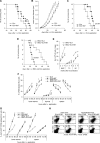Anti-CD44 induces apoptosis in T lymphoma via mitochondrial depolarization
- PMID: 19765170
- PMCID: PMC3829012
- DOI: 10.1111/j.1582-4934.2009.00909.x
Anti-CD44 induces apoptosis in T lymphoma via mitochondrial depolarization
Abstract
A blockade of CD44 can interfere with haematopoietic and leukemic stem cell homing, the latter being considered as a therapeutic option in haematological malignancies. We here aimed to explore the molecular mechanism underlying the therapeutic efficacy of anti-CD44. We noted that in irradiated mice reconstituted with a bone marrow cell transplant, anti-CD44 exerts a stronger effect on haematopoietic reconstitution than on T lymphoma (EL4) growth. Nonetheless, in the non-reconstituted mouse anti-CD44 suffices for a prolonged survival of EL4-bearing mice, where anti-CD44-prohibited homing actively drives EL4 cells into apoptosis. In vitro, a CD44 occupancy results in a 2-4-fold increase in apoptotic EL4 cells. Death receptor expression (CD95, TRAIL, TNFRI) remains unaltered and CD95 cross-linking-mediated apoptosis is not affected. Instead, CD44 ligation promotes mitochondrial depolarization that is accompanied by caspase-9 cleavage and is inhibited in the presence of a caspase-9 inhibitor. Apoptosis becomes initiated by activation of CD44-associated phosphatase 2A (PP2A) and proceeds via ERK1/2 dephosphorylation without ERK1/2 degradation. Accordingly, CD44-induced apoptosis could be mimicked by ERK1/2 inhibition, that also promotes EL4 cell apoptosis through the mitochondrial pathway. Thus, during haematopoietic stem cell reconstitution care should be taken not to interfere by a blockade of CD44 with haematopoiesis, which could be circumvented by selectively targeting leukemic CD44 isoforms. Beyond homing/settlement in the bone marrow niche, anti-CD44 drives leukemic T cells into apoptosis via the mitochondrial death pathway by CD44 associating with PP2A. Uncovering this new pathway of CD44-induced leukemic cell death provides new options of therapeutic interference.
Figures







Similar articles
-
CD44 standard and CD44v10 isoform expression on leukemia cells distinctly influences niche embedding of hematopoietic stem cells.J Hematol Oncol. 2014 Mar 31;7:29. doi: 10.1186/1756-8722-7-29. J Hematol Oncol. 2014. PMID: 24684724 Free PMC article.
-
Cooperativity of CD44 and CD49d in leukemia cell homing, migration, and survival offers a means for therapeutic attack.J Immunol. 2013 Nov 15;191(10):5304-16. doi: 10.4049/jimmunol.1301543. Epub 2013 Oct 14. J Immunol. 2013. PMID: 24127558
-
CD44v10, osteopontin and lymphoma growth retardation by a CD44v10-specific antibody.Immunol Cell Biol. 2014 Sep;92(8):709-20. doi: 10.1038/icb.2014.47. Epub 2014 Jun 17. Immunol Cell Biol. 2014. PMID: 24935458
-
CD44v6 promotes proliferation by persisting activation of MAP kinases.Cell Signal. 2005 Aug;17(8):961-73. doi: 10.1016/j.cellsig.2004.11.017. Epub 2004 Dec 24. Cell Signal. 2005. PMID: 15894169
-
CD44 promotes progenitor homing into the thymus and T cell maturation.J Leukoc Biol. 2009 Feb;85(2):251-61. doi: 10.1189/jlb.0608389. Epub 2008 Oct 27. J Leukoc Biol. 2009. PMID: 18955544
Cited by
-
CD44 induced enhancement of phosphatase activity and calcium influx: Modifications of EGR-1 expression and cell proliferation.Biochem Biophys Rep. 2016 Apr 1;6:172-178. doi: 10.1016/j.bbrep.2016.03.016. eCollection 2016 Jul. Biochem Biophys Rep. 2016. PMID: 28955875 Free PMC article.
-
The T/Tn-Specific Helix pomatia Lectin Induces Cell Death in Lymphoma Cells Negative for T/Tn Antigens.Cancers (Basel). 2021 Aug 28;13(17):4356. doi: 10.3390/cancers13174356. Cancers (Basel). 2021. PMID: 34503166 Free PMC article.
-
Co-treatment of tumor cells with hyaluronan plus doxorubicin affects endothelial cell behavior independently of VEGF expression.Oncotarget. 2018 Nov 27;9(93):36585-36602. doi: 10.18632/oncotarget.26379. eCollection 2018 Nov 27. Oncotarget. 2018. PMID: 30564299 Free PMC article.
-
An easy method to detect the kinetics of CD44 antibody and its receptors on B16 cells using atomic force microscopy.Mol Biol Rep. 2011 Oct;38(7):4495-500. doi: 10.1007/s11033-010-0580-6. Epub 2010 Dec 8. Mol Biol Rep. 2011. PMID: 21140224
-
CD44 standard and CD44v10 isoform expression on leukemia cells distinctly influences niche embedding of hematopoietic stem cells.J Hematol Oncol. 2014 Mar 31;7:29. doi: 10.1186/1756-8722-7-29. J Hematol Oncol. 2014. PMID: 24684724 Free PMC article.
References
-
- Lynch KW. Consequences of regulated pre-mRNA splicing in the immune system. Nat Rev Immunol. 2004;4:931–40. - PubMed
-
- Naor D, Wallach-Dayan SB, Zahalka MA, Sionov RV. Involvement of CD44, a molecule with a thousand faces, in cancer dissemination. Semin Cancer Biol. 2008;18:260–7. - PubMed
-
- Orian-Rousseau V, Ponta H. Adhesion proteins meet receptors: a common theme. Adv Cancer Res. 2008;101:63–92. - PubMed
-
- Lapidot T, Dar A, Kollet O. How do stem cells find their way home? Blood. 2005;106:1901–10. - PubMed
Publication types
MeSH terms
Substances
LinkOut - more resources
Full Text Sources
Medical
Research Materials
Miscellaneous

